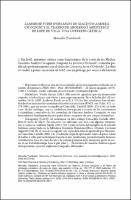Chapter L’amorose furie d’Orlando de Giacinto Andrea Cicognini y el teatro de abolengo ariostesco de Lope de Vega: una cuestión crítica pendiente
| dc.contributor.author | TRAMBAIOLI, Marcella | |
| dc.date.accessioned | 2022-06-01T12:17:15Z | |
| dc.date.available | 2022-06-01T12:17:15Z | |
| dc.date.issued | 2020 | |
| dc.identifier | ONIX_20220601_9788855181501_429 | |
| dc.identifier.issn | 2704-5919 | |
| dc.identifier.uri | https://library.oapen.org/handle/20.500.12657/56246 | |
| dc.description.abstract | In order to highlight the intertextual game that Giacinto Andrea Cicognini creates in it L’amorose furie d’Orlando with Angélica en el Catay by Lope de Vega, a hypothesis vented but not demonstrated by Gobbi in an ancient critical essay, it is necessary to read and reread the two comedies without losing sight of the octaves of Ariosto with a meticulousness that, until now, no one had believed necessary to put in place, perhaps because in both cases we are not faced with absolute masterpieces. In any case, if it is true that certain images and phrases can fall into the category of literary interdiscursiveness, which goes beyond the two plays analyzed, the fact remains that the numerous similarities identified cannot be the result of chance. | |
| dc.language | Italian | |
| dc.relation.ispartofseries | Studi e saggi | |
| dc.subject.other | Giacinto Andrea Cicognini | |
| dc.subject.other | L'amorose furie d'Orlando | |
| dc.subject.other | Lope de Vega | |
| dc.title | Chapter L’amorose furie d’Orlando de Giacinto Andrea Cicognini y el teatro de abolengo ariostesco de Lope de Vega: una cuestión crítica pendiente | |
| dc.type | chapter | |
| oapen.identifier.doi | 10.36253/978-88-5518-150-1.11 | |
| oapen.relation.isPublishedBy | bf65d21a-78e5-4ba2-983a-dbfa90962870 | |
| oapen.relation.isbn | 9788855181501 | |
| oapen.series.number | 209 | |
| oapen.pages | 19 | |
| oapen.place.publication | Florence |

